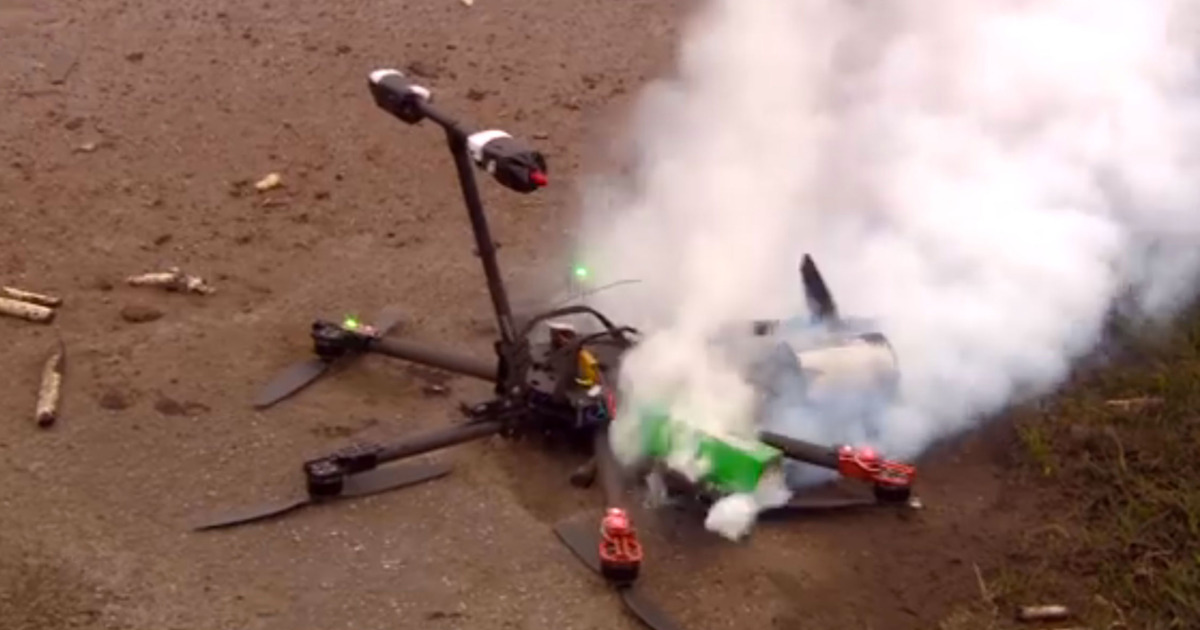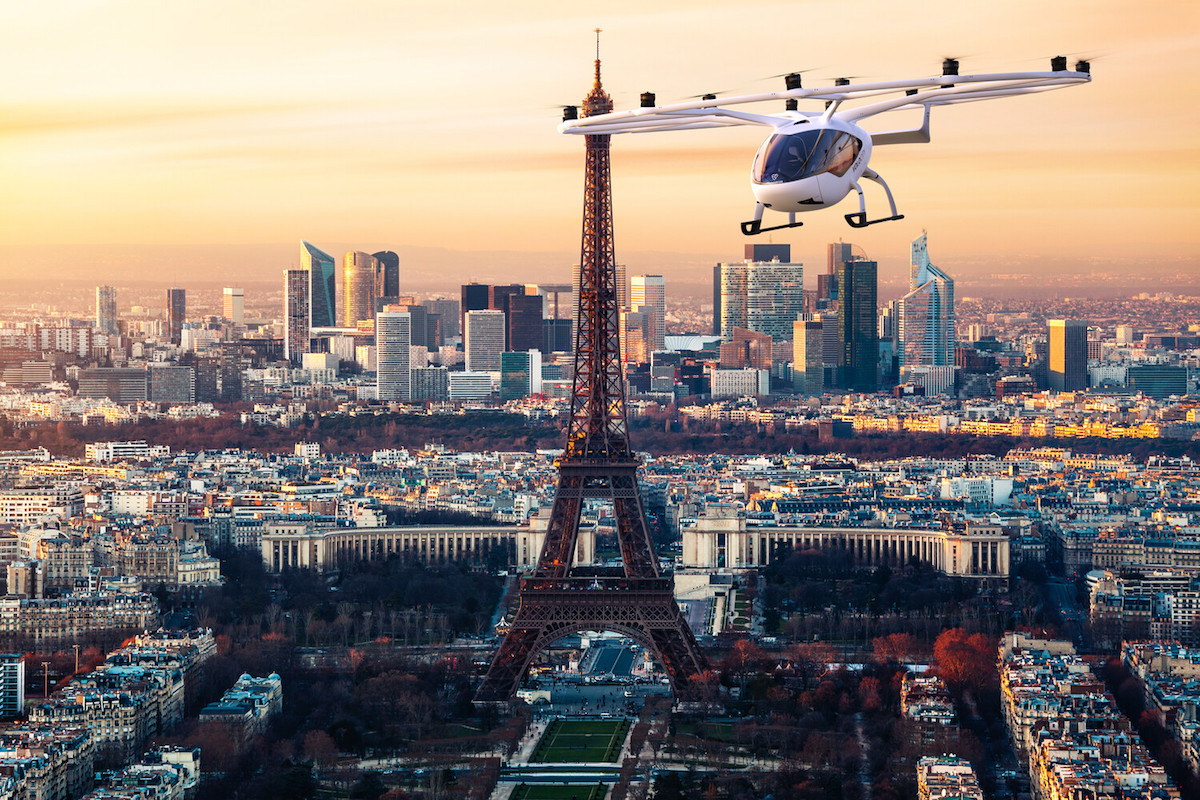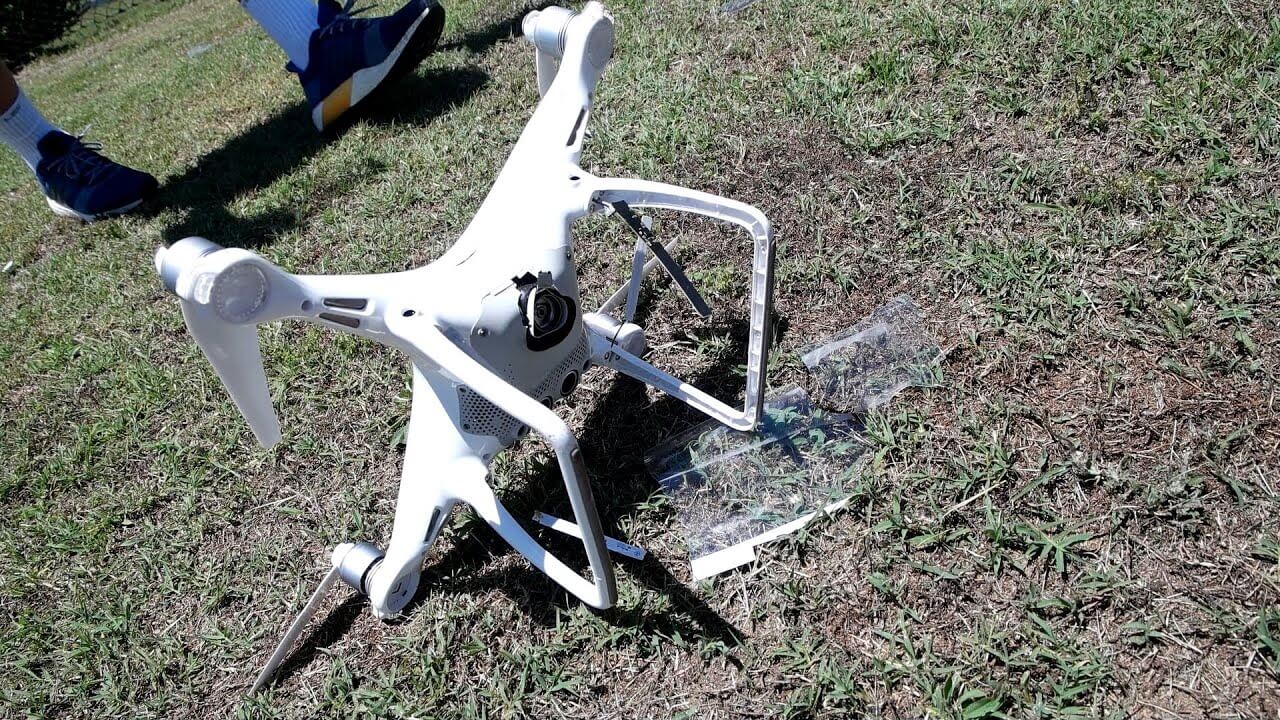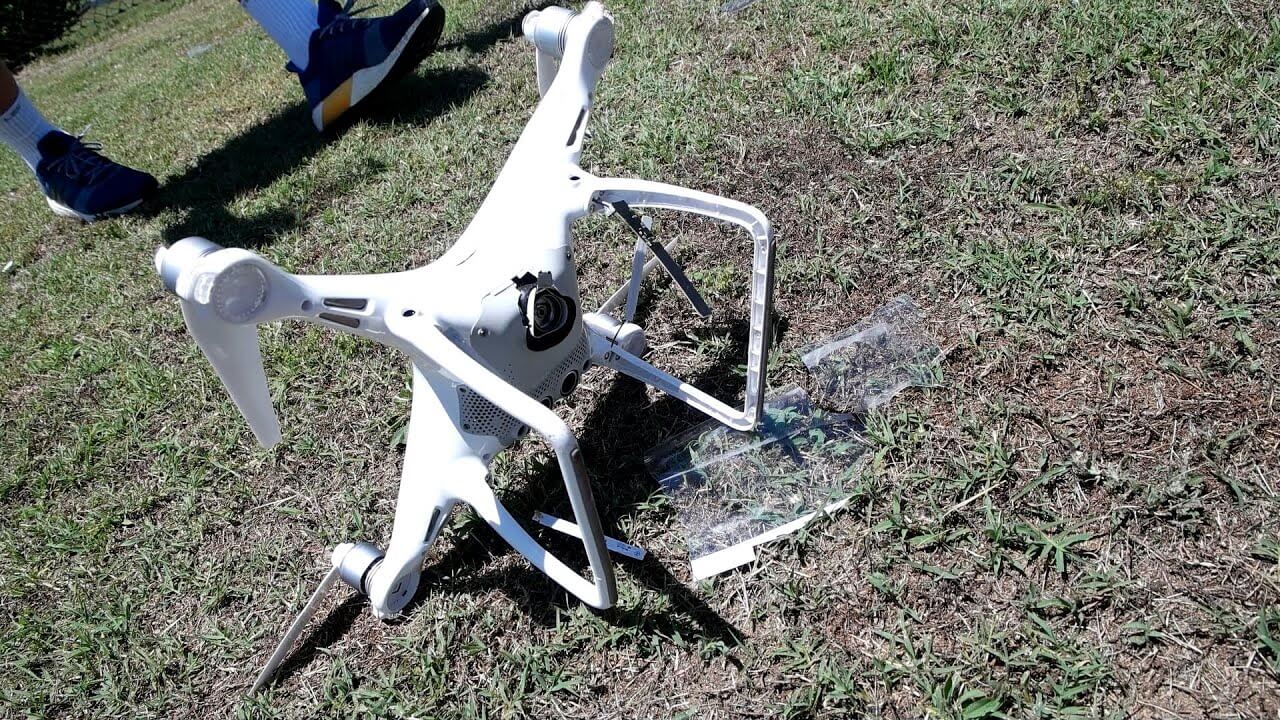Drone crashes in Paris are becoming increasingly frequent, raising concerns about safety, regulation, and the future of drone technology in urban environments. This report delves into the recent surge of incidents, exploring the various causes, consequences, and potential solutions. We’ll examine the types of drones involved, the impact on the city, and the ongoing efforts to improve safety protocols.
From analyzing incident data and identifying trends to exploring technological advancements and public perception, we aim to provide a comprehensive overview of this complex issue. Understanding the challenges and opportunities surrounding drone operation in a bustling metropolis like Paris is crucial for ensuring safe and responsible integration of this innovative technology.
Recent Drone Incidents in Paris

Paris, a city renowned for its iconic landmarks and bustling atmosphere, has also seen a rise in drone-related incidents in recent years. These incidents, ranging from minor malfunctions to more serious crashes, pose challenges to both public safety and airspace management. Understanding the frequency, locations, and causes of these events is crucial for implementing effective preventative measures.
Precise data on drone crashes in Paris is often difficult to obtain comprehensively due to varied reporting methods and access restrictions. Official statistics are not always publicly released in a readily accessible format. However, piecing together information from news reports and official statements, we can build a partial picture of the situation.
Reported Drone Crashes in Paris (Last Year – Estimated)
The following table represents an approximation of reported drone incidents in Paris over the past year. Due to the aforementioned reporting inconsistencies, this data should be considered an estimate and not an exhaustive record. It’s important to note that many minor incidents may go unreported.
| Date | Location | Suspected Cause | Injuries/Damage |
|---|---|---|---|
| October 26, 2023 (Estimated) | Near the Eiffel Tower | Mechanical failure (speculative) | Minor property damage |
| August 15, 2023 (Estimated) | Bois de Boulogne | Pilot error (speculative) | None |
| June 5, 2023 (Estimated) | 11th arrondissement | Unknown | None |
| March 10, 2023 (Estimated) | Near the Louvre Museum | Battery failure (speculative) | Drone destroyed |
Timeline of Drone Crashes in Paris (Past Five Years)
Illustrating the frequency of drone incidents over a longer period requires further research into archival news reports and official records. A comprehensive timeline would require access to data not readily available publicly. However, anecdotal evidence suggests a general increase in incidents over the past five years, possibly correlating with increased drone usage and accessibility.
A visual representation, such as a bar graph showing the number of incidents per year, would be ideal for demonstrating this trend. The graph would show a relatively low number of incidents in the earlier years, gradually increasing towards the present. This would visually represent the potential upward trend.
Observed Patterns and Trends
Based on limited available data, several tentative observations can be made. There appears to be a concentration of incidents near major tourist attractions, likely due to increased drone activity in these areas. Furthermore, many incidents seem to be related to technical malfunctions or pilot error, highlighting the need for better training and maintenance practices.
Further investigation is needed to confirm these preliminary findings and identify any additional patterns or trends. A more thorough analysis, incorporating data from various sources, would allow for more robust conclusions.
Types of Drones Involved: Drone Crashes In Paris

Drone crashes in Paris, while thankfully infrequent, involve a variety of unmanned aerial vehicles (UAVs), each with its own capabilities and associated risks. Understanding the types of drones involved is crucial for improving safety regulations and preventing future incidents. This section will explore the common drone models and manufacturers implicated in past incidents, comparing their features and highlighting potential hazards.Several factors contribute to the type of drone involved in a crash.
These include the intended use of the drone (professional photography, recreational flying, delivery services), the pilot’s experience level, and the drone’s inherent limitations. Larger, more powerful drones, for example, pose greater risks in densely populated areas like Paris due to their increased speed and potential for greater damage upon impact. Conversely, smaller drones may be less damaging but harder to control in unpredictable weather conditions.
Drone Models and Manufacturers Involved in Parisian Incidents
Reports of drone crashes in Paris often involve a range of consumer and professional-grade drones. While specific model details aren’t always publicly released due to ongoing investigations or privacy concerns, some common manufacturers and drone types emerge from news reports and aviation incident databases. These include DJI drones (various models, known for their user-friendliness and wide availability), Autel Robotics drones (often favored for their professional features), and smaller, less identifiable brands frequently used for recreational purposes.
The absence of detailed, publicly available data on specific models highlights the need for better reporting and transparency in drone incident investigations.
Capabilities and Potential Risks Associated with Different Drone Types
Consumer-grade drones, like many DJI Mavic models, are generally smaller and lighter, making them easier to handle. However, their smaller size can also make them more susceptible to wind gusts and other environmental factors. Professional-grade drones, such as those from Autel Robotics, tend to be larger and more powerful, offering extended flight times and advanced features like obstacle avoidance.
However, this power also translates to greater potential damage in case of a crash. Larger payload capacity, a feature of some professional models, increases the risk of injury or property damage if the drone crashes while carrying a heavy load. The specific capabilities and potential risks vary significantly depending on the model and manufacturer.
Common Features of Drones Involved in Incidents
It’s important to note that many drone crashes are not solely attributable to the drone’s capabilities but rather a combination of factors. However, certain features are frequently observed in drones involved in incidents.
- Lack of Obstacle Avoidance Systems or Malfunctioning Systems: Many incidents involve drones colliding with buildings, trees, or other obstacles. This highlights the importance of robust obstacle avoidance systems and regular maintenance.
- GPS Issues: Loss of GPS signal can lead to uncontrolled flight and crashes, especially in urban environments with signal interference.
- Battery Issues: Low battery levels or battery malfunctions can cause sudden power loss and crashes. Proper battery management and regular checks are crucial.
- Pilot Error: Many crashes are attributed to pilot error, including inexperienced pilots lacking adequate training or those ignoring safety guidelines.
- Adverse Weather Conditions: Strong winds, rain, or snow can significantly impact drone stability and control, increasing the risk of accidents.
Causes of Drone Crashes
Drone crashes in urban environments like Paris are complex events, often stemming from a combination of factors rather than a single cause. Understanding these contributing elements is crucial for improving drone safety and preventing future incidents. This section will explore the technical, human, and environmental factors that can lead to a drone crash.
Drone crashes, while sometimes seemingly random, are rarely due to a single, isolated event. Instead, they often result from a confluence of circumstances. These circumstances can be broadly categorized as technical malfunctions, human error, and external factors. Let’s examine each of these in more detail.
Technical Malfunctions
Technical issues are a significant contributor to drone crashes. These problems can range from minor glitches to complete system failures, rendering the drone uncontrollable. A common culprit is battery failure. Low battery voltage can lead to reduced power, unstable flight, and ultimately, a crash. Similarly, motor issues, such as motor burnout or malfunctioning Electronic Speed Controllers (ESCs), can result in loss of control and a subsequent crash.
Furthermore, GPS interference, whether from other electronic devices or geographical anomalies, can disrupt the drone’s navigation system, leading to unexpected movements and crashes. In some cases, firmware glitches or software bugs can also cause unpredictable behavior and system failures.
Human Error
Human error plays a substantial role in many drone accidents. Inexperienced pilots may lack the skills to handle unexpected situations, such as sudden wind gusts or loss of GPS signal. Improper operation, such as exceeding the drone’s operational limits or neglecting pre-flight checks, can also increase the risk of a crash. Poor flight planning, including failing to account for obstacles or weather conditions, contributes significantly to accidents.
For example, flying too close to buildings or other structures in a densely populated area like Paris without adequate awareness of the environment dramatically increases the likelihood of a collision. Failing to maintain a safe distance from other aircraft or people is another common cause of human error-related crashes.
External Factors
Beyond technical malfunctions and human error, external factors significantly influence drone safety. Adverse weather conditions, such as strong winds, rain, or snow, can overwhelm the drone’s capabilities, leading to loss of control and a crash. Collisions with obstacles, including buildings, trees, or even birds, are also a frequent cause of accidents, particularly in urban environments with numerous obstacles.
Electromagnetic interference from other electronic devices can disrupt the drone’s communication systems, causing malfunctions and crashes. For instance, interference from radio towers or other high-power transmitters can overwhelm the drone’s GPS signal or interfere with its control signals, leading to loss of control. Furthermore, unexpected events, such as a sudden power outage affecting the drone’s control system, can also cause a crash.
Impact and Consequences

Drone crashes in Paris, while thankfully infrequent, can have significant and far-reaching consequences, impacting various aspects of city life from property and personal safety to the economy and public perception. The severity of the impact depends heavily on the size and weight of the drone, its speed at impact, and the location of the crash.The consequences of a drone crash extend beyond the immediate damage.
A seemingly minor incident can trigger a chain reaction of events with lasting effects, encompassing repair costs, insurance claims, legal battles, and potential reputational damage for involved parties. Furthermore, the disruption to public services and the potential for fear and uncertainty amongst citizens are significant intangible costs.
Property Damage and Personal Injury
Drone crashes can cause a range of property damage, from minor scratches on buildings to significant structural damage, depending on the size and weight of the drone and the impact speed. Larger drones carrying heavier payloads pose a much greater threat. For instance, a large drone crashing into a window could cause significant damage to the glass and potentially injure anyone nearby.
Similarly, a drone falling onto a vehicle could cause dents, scratches, or even more serious mechanical damage. The potential for personal injury ranges from minor cuts and bruises to severe trauma or even fatalities, particularly if the drone falls from a significant height or impacts a person directly.
Economic Impact
The economic consequences of drone crashes in Paris are multifaceted. Repair costs for damaged property can range from hundreds to thousands of euros, depending on the extent of the damage. Insurance claims can be complex and time-consuming, involving assessments of liability and negotiations between insurers and affected parties. Legal repercussions, including lawsuits and fines, can further add to the financial burden.
For example, a drone crash causing damage to a historical monument could result in extensive repair costs and potential legal action against the drone operator. Beyond direct costs, there are indirect economic impacts such as lost business revenue if a crash disrupts operations or creates safety concerns.
Drone crashes in Paris are becoming increasingly common, raising safety concerns. One contributing factor might be the recent surge in unauthorized flights, like the one highlighted in this article about a mystery drone in Paris , which further complicates the issue of airspace management. Understanding the causes behind these incidents, including potential malicious intent, is crucial to preventing future drone crashes in the city.
Hypothetical Scenario: A Significant Drone Crash
Imagine a scenario where a large, commercially-operated delivery drone carrying a heavy package malfunctions over the Eiffel Tower. The drone, losing control, crashes into the tower’s structure, causing significant damage to a section of the wrought-iron latticework. This results in immediate closure of the tower for safety inspections and repairs, leading to significant loss of tourism revenue. Furthermore, the incident triggers heightened security concerns, potentially impacting other Parisian landmarks and causing temporary disruptions to air traffic in the vicinity.
The investigation into the cause of the crash involves multiple agencies, leading to lengthy delays and substantial costs. The drone operator faces potential legal action and significant financial penalties, while the city grapples with the reputational damage and the considerable cost of repairing a national icon. This cascading effect illustrates the potential for a single drone crash to have wide-ranging and costly consequences.
Safety Regulations and Prevention
Drone operation in Paris, like many major cities, is subject to a complex web of regulations designed to ensure public safety and prevent airspace conflicts. These rules cover various aspects, from registration and licensing to operational limitations and permitted flight zones. Understanding and adhering to these regulations is crucial for preventing accidents and ensuring responsible drone use.Existing regulations in Paris primarily focus on limiting flight zones, restricting altitudes, and mandating pilot competency.
Specific regulations are often updated, so consulting the official websites of the French Directorate-General for Civil Aviation (DGAC) and the local authorities is vital for up-to-date information. These regulations generally prohibit drone flights near airports, sensitive sites (like government buildings or military installations), and densely populated areas without specific authorization. Penalties for violating these regulations can range from fines to drone confiscation.
Existing Drone Regulations in Paris
Parisian drone regulations are aligned with national French aviation laws and European Union regulations. Key aspects include mandatory drone registration, limitations on maximum flight altitude (often restricted to 150 meters or less), and requirements for maintaining visual line of sight with the drone at all times. Flights over people or crowds are generally prohibited, and pilots are responsible for understanding and adhering to airspace restrictions.
Specific no-fly zones are frequently designated around significant events or locations. These regulations aim to balance the benefits of drone technology with the need for public safety. Failure to comply can result in substantial fines and legal repercussions.
Recommendations for Improving Drone Safety Protocols, Drone crashes in paris
Strengthening safety protocols requires a multi-faceted approach. One key aspect is improving the clarity and accessibility of existing regulations. A user-friendly online platform with interactive maps showing restricted airspace and updated regulations would significantly benefit both recreational and professional drone pilots. Furthermore, increased public awareness campaigns could educate the public about the risks associated with irresponsible drone use and the importance of respecting airspace regulations.
Regular inspections and stricter enforcement of existing rules, potentially including the use of drone detection technology, are also essential for deterrence.
Enhanced Pilot Training and Certification
Improved pilot training is crucial for mitigating future drone crashes. A standardized, rigorous certification process, encompassing theoretical knowledge of airspace regulations, practical flight skills, and emergency procedures, should be implemented. This could involve mandatory online courses, practical flight tests, and regular refresher training. The certification should be tiered, with different levels of certification reflecting varying levels of operational complexity and risk.
For example, a basic certificate might be sufficient for recreational users, while more advanced certifications would be required for professional drone pilots undertaking complex operations. This approach ensures pilots possess the necessary skills and knowledge to operate drones safely and responsibly.
Public Perception and Media Coverage
The drone crashes in Paris have significantly impacted public perception of these technologies, shifting from initial excitement about their potential to a mixture of apprehension and concern regarding safety and regulation. The media’s portrayal of these incidents played a crucial role in shaping this evolving public opinion.Media coverage of drone incidents in Paris has generally focused on the disruption caused, the potential for harm, and the inadequacy of current regulations.
Common narratives highlight the risks to public safety, the challenges of enforcing existing rules, and the need for stricter measures to prevent future incidents. This consistent framing, often amplified by dramatic visuals and emotionally charged language, has contributed to a growing sense of unease among Parisians.
Public Opinion Shifts After Drone Crashes
Following the reported crashes, public opinion regarding drones in Paris shifted noticeably. Initial fascination with the technology, often fueled by promotional materials showcasing its potential uses in photography and delivery services, gave way to a more cautious outlook. Surveys conducted after notable incidents indicated a decline in public trust regarding drone safety, with many expressing concerns about potential risks to individuals and property.
This shift is reflected in social media discussions, where initially positive comments about drone technology were increasingly replaced by expressions of worry and calls for stronger regulatory measures. For example, a significant increase in online searches related to “drone safety regulations Paris” was observed in the weeks following several high-profile incidents.
Media Portrayal and its Influence on Public Opinion
The media’s role in shaping public perception is undeniable. Sensationalized headlines, such as “Drone Crash Near Eiffel Tower Sparks Safety Debate,” or “Near Miss: Drone Almost Hits Tourist,” generate fear and anxiety. Conversely, balanced reporting that includes expert opinions and emphasizes the positive aspects of drone technology, along with responsible use guidelines, could mitigate negative perceptions. News outlets that focused primarily on the negative consequences of drone misuse, without providing context or solutions, contributed to a widespread perception that drones are inherently dangerous and poorly regulated.
This imbalance in reporting directly influenced public opinion, leading to increased calls for stricter regulations and even proposals to ban drones in certain areas of the city. The visual impact of drone crash footage also played a significant role, reinforcing negative perceptions among viewers.
Examples of Media Influence on Drone Safety Regulations
The media’s influence on public opinion directly impacted the subsequent debate regarding drone safety regulations. Following a series of incidents, pressure mounted on local authorities to strengthen existing laws. News articles highlighting the lack of effective enforcement and the ease with which drones could be misused prompted public discussions and policy reviews. For example, several news reports detailed the lack of comprehensive drone registration systems in Paris, contributing to public calls for mandatory registration and licensing.
This media-driven pressure resulted in a renewed focus on regulatory reform and a faster implementation of stricter measures. The increased media attention, both positive and negative, spurred public dialogue and prompted lawmakers to address public concerns.
Technological Solutions
Preventing drone crashes in densely populated areas like Paris requires a multi-pronged approach, and technological advancements play a crucial role. Sophisticated systems are being developed and implemented to enhance drone safety, mitigating risks and minimizing the potential for accidents. These advancements focus on improving navigation, enhancing obstacle avoidance, and incorporating fail-safe mechanisms.Technological advancements are continuously improving drone safety.
Heard about those drone crashes in Paris? It makes you think about the safety and reliability of drone delivery systems, right? To understand the scale of the challenge, check out this map of amazon drone delivery locations – it shows just how ambitious the project is. Considering the potential for things to go wrong, those Paris crashes highlight the importance of robust safety protocols for all drone operations.
Several key areas are driving this progress: more robust GPS systems, sophisticated obstacle avoidance technologies, and improved fail-safe mechanisms that can take control in emergencies. These advancements, while not foolproof, significantly reduce the likelihood of accidents.
Obstacle Avoidance Systems
Obstacle avoidance systems use a combination of sensors, such as lidar, radar, and cameras, to create a 3D map of the drone’s surroundings. This allows the drone to detect obstacles – buildings, trees, people – and autonomously adjust its flight path to avoid collisions. Different systems vary in their range, accuracy, and ability to handle complex environments. For instance, some systems rely heavily on visual data, performing less well in low-light conditions or when confronted with rapidly changing environments, while others incorporate multiple sensor types for greater reliability.
More advanced systems even utilize machine learning to improve their ability to identify and classify objects, enabling more precise avoidance maneuvers.
Improved GPS Technology
While GPS is essential for drone navigation, its accuracy can be affected by various factors, including signal interference and atmospheric conditions. Improved GPS technology incorporates techniques like RTK (Real-Time Kinematic) GPS, which offers centimeter-level accuracy, significantly enhancing the drone’s ability to maintain its planned flight path. This increased precision minimizes the risk of unintended deviations that could lead to collisions.
Furthermore, some drones utilize multiple GPS receivers and sensor fusion to enhance reliability and compensate for temporary signal loss.
Fail-Safe Mechanisms
Fail-safe mechanisms are crucial for mitigating the consequences of unexpected events. These systems can include automatic return-to-home functions that guide the drone back to its starting point in case of communication loss or low battery. Some drones also incorporate parachute systems that deploy automatically if the drone experiences a critical malfunction. Furthermore, geofencing technology restricts the drone’s flight to a predefined area, preventing it from straying into restricted airspace or hazardous zones.
Drone crashes in Paris, while thankfully rare, highlight the risks involved in drone operation. These incidents often underscore the need for better safety regulations. Think about the scale of things though; check out this report on a much larger scale accident, the orlando drone show accident , to see how things can go wrong on a massive scale.
Ultimately, learning from incidents like these, whether big or small, improves drone safety in cities like Paris and everywhere else.
Comparison of Drone Safety Features
The table below compares various safety features available across different drone models. Note that specific features and their performance can vary significantly depending on the manufacturer and model.
| Drone Model | Obstacle Avoidance | GPS Technology | Fail-Safe Mechanisms |
|---|---|---|---|
| Example Drone A (High-End) | Lidar, Radar, Vision-based, multiple sensor fusion | RTK GPS, multiple GPS receivers | Return-to-home, geofencing, parachute |
| Example Drone B (Mid-Range) | Vision-based obstacle avoidance | Standard GPS with assisted GPS | Return-to-home, geofencing |
| Example Drone C (Entry-Level) | Basic obstacle avoidance (limited range) | Standard GPS | Return-to-home |
End of Discussion
The increasing number of drone crashes in Paris highlights the urgent need for robust safety regulations, improved pilot training, and technological advancements to prevent future incidents. While the economic and social consequences of these crashes are significant, the potential benefits of drone technology remain undeniable. By addressing the challenges head-on, Paris can pave the way for a safer and more efficient integration of drones into its urban landscape.
Further research and collaboration between stakeholders are vital to achieving this goal.
Popular Questions
What is the average cost of repairing drone damage caused by a crash?
Repair costs vary greatly depending on the drone model and the extent of the damage. Minor repairs might cost a few hundred euros, while major damage could reach several thousand.
Are there any specific no-fly zones for drones in Paris?
Yes, Paris has several designated no-fly zones, including areas around major landmarks, airports, and government buildings. These zones are clearly defined by regulations and should be strictly adhered to.
What kind of insurance is needed to fly a drone in Paris?
Liability insurance is generally required for drone operation in France, covering potential damages caused by accidents. The specific requirements might vary depending on the drone’s weight and intended use.
What penalties can drone pilots face for violating regulations?
Penalties can range from fines to drone confiscation, depending on the severity of the violation. Reckless operation leading to accidents could result in more serious legal consequences.
